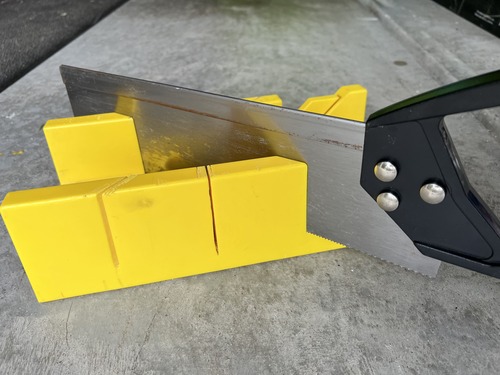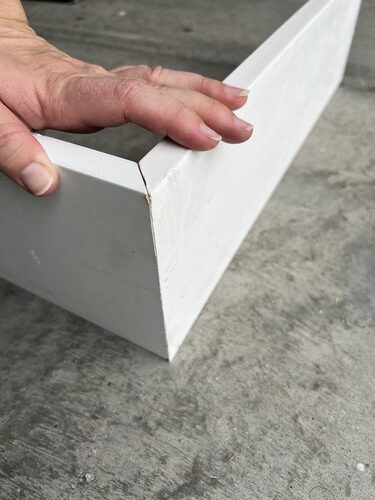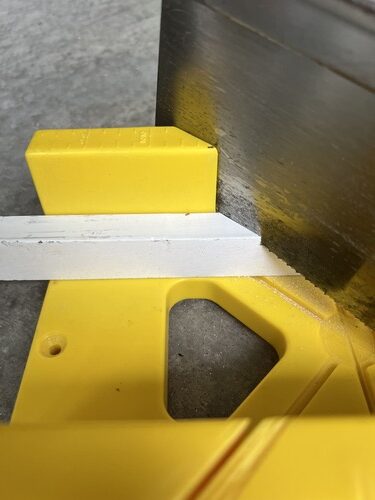
Installing new baseboards is an essential step in finishing a room, providing a clean and polished look that covers the joint between the wall and the floor. A well-installed base board can significantly enhance the aesthetic appeal of a space, adding a touch of sophistication and completeness. But, how to cut baseboard corners without miter saw is the biggest question we get.
Typically, a miter saw is the go-to tool for cutting baseboard miter joint corners with precision, but not everyone has access to one. You might be working in a small space where setting up a large power tool isn’t practical, or perhaps you’re just starting out with DIY projects and haven’t yet invested in a miter saw.
The good news is that you don’t need to own expensive equipment to achieve professional-looking results. With the right hand tools and techniques, you can cut baseboard miter angle corners just as effectively.
Whether you’re a seasoned DIY enthusiast or simply looking to save money on tools, this guide will walk you through the process of cutting baseboard corners without a miter saw. By following these simple steps, you can ensure that your baseboards fit perfectly in every corner, giving your room a polished and finished appearance.
Tools You’ll Need to Cut Baseboards without a Miter Saw



Before you begin, gather the following tools:
- Hand Saw: A fine-toothed hand saw works well for making clean cuts.
- Miter Cut Box: A miter box helps guide your hand saw for accurate angled cuts.
- Coping Saw: Used for coping the inside corners of the baseboards.
- Measuring Tape: For accurate measurements.
- Pencil: To mark your cuts.
- Sandpaper or File: To smooth out any rough edges.
- Clamps (Optional): To hold the baseboard in place while cutting.
Step-by-Step Instructions to Cut Baseboards without a Miter Saw
1. Measure and Mark the Baseboard
Start by measuring the length of the wall where the baseboard will be installed. Use a tape measure to get an accurate measurement and mark the baseboard with a pencil where the cut will be made.
- Tip: Best Practice is to always measure twice to ensure accuracy. It’s better to cut slightly longer and trim down if needed than to cut too short.

2. Cutting Outside Corners with a Hand Saw and Miter Box
For outside corner cuts (where two walls meet and form an external angle), you’ll need to cut the baseboard at a 45-degree angle.
- Place the baseboard in the miter box: Position the baseboard in the miter box, aligning the marked cut line with the 45-degree slot.
- Cut the baseboard: Use a fine-toothed hand saw to make the cut, following the guide provided by the miter box.
- Tip: If you don’t have a miter box, you can create a 45-degree angle template using a piece of cardboard or wood and use it to guide your hand saw.

3. Cutting Inside Corners with a Coping Saw
Inside corners cuts (where two walls meet and form an internal angle) are best handled by coping the joint. This method creates a more seamless fit than simply butting the two pieces together.
- Cut a 45-degree angle first: Start by cutting one of the baseboards at a 45-degree angle using the miter box and hand saw, as described above.
- Cope the cut piece edge: Using the coping saw, carefully cut along the profile of the cut edge, following the curve created by the 45-degree cut. This will allow the second piece of baseboard to fit snugly against the inner corner coped joint.
- Tip: Practice coping on a scrap piece of baseboard before attempting it on your actual pieces. This will help you get the hang of the technique.


4. Test Fit and Adjust
Once you’ve made your cuts, it’s important to test fit the pieces before nailing them in place.
- Dry fit the pieces: Place the baseboards against the wall and check the fit at the corners. If the fit isn’t perfect, you can trim small amounts with the coping saw or sandpaper until you’re satisfied with the result.
- Tip: If you notice any gaps, you can fill them with wood filler or caulk before painting or staining the baseboards.
5. Secure the Baseboards
Once the baseboards fit together perfectly, it’s time to secure them to the wall.
- Nail the baseboards in place: Use a power brad nailer to attach the baseboards to the wall. Be sure to use a stud finder to nail into the studs for a secure hold.
- Fill and finish: Fill the nail holes with wood filler and sand them smooth. Once the filler is dry, you can paint or stain the baseboards to match your décor.
Common Mistakes to Avoid
- Rushing the Coping Process: Coping requires patience and precision. Take your time to ensure a clean, snug fit.
- Ignoring Test Fitting: For best results always test fit the baseboards before securing them. It’s much easier to make adjustments before the pieces are nailed in place.
- Skipping the Miter Box: Even though it’s a simple tool, a miter box significantly improves the accuracy of your angle cuts. Don’t skip it!
- Not wearing safety gear: Wearing protective safety goggles is so important in making sure nothing foreign ends up in your eyes.
Cutting baseboard corners without a miter saw may seem challenging at first, but with the right tools, techniques, and a bit of patience, it’s entirely achievable. Whether you’re dealing with an inside or outside corner, taking the time to measure accurately, precise cut carefully, and test fit will ensure a professional-looking finish that enhances the overall appearance of your space.
The sense of accomplishment you’ll feel from successfully installing your baseboards without relying on power tools is well worth the effort.
By mastering these techniques, you can confidently tackle baseboard installations in any room, knowing that you have the skills to achieve tight-fitting corners that look just as good as those made with a miter saw.
Plus, you’ll have gained valuable experience that can be applied to future projects, making you a more versatile and capable DIYer. Remember, the key to success is precision and practice, so take your time, follow the steps carefully, and enjoy the satisfaction of a job well done.
Cutting baseboard corners can be a challenge without a miter saw, but it’s totally doable! For other DIY tips, see our Best Paint Brushes for Baseboards guide, and if you’re setting up a workspace, try our DIY Custom Office Corner Desk tutorial.
If or when you decide to tackle How to Cut Baseboard Corners Without a Miter Saw Tutorial, I’d love for you to tag us on Instagram so I can see your really fun recipes and DIY projects come to life!
COZY HOME, COZY RECIPES:
Every cozy home deserves amazing recipes, and it’s even better when those recipes are both delicious and healthy. Our goal is to provide tasty meals that are easy to make, regardless of your skill level.
Fast, easy meals leave more time for fun activities, making your home a hub of joy and good food.
CONNECT WITH US:
As always, we love hearing about your experiences with our “How to Cut Baseboard Corners Without a Miter Saw Tutorial”. Reach out to us through our social channels. Any questions you have, we’re here to answer.
Stay updated by joining our newsletter, offering a monthly dose of new recipes and a first look at upcoming projects.
MORE COZY KITCHEN RECIPES:
If you’re hungry for more, explore our collection of Cozy Kitchen Recipes. Another healthy favorite is the “Sausage Potato Veggie Bake.” Find these recipes and more here.
DIY RESOURCES:
For additional resources, check out our DIY Tutorials, offering a wealth of information to enhance your home improvement skills.
